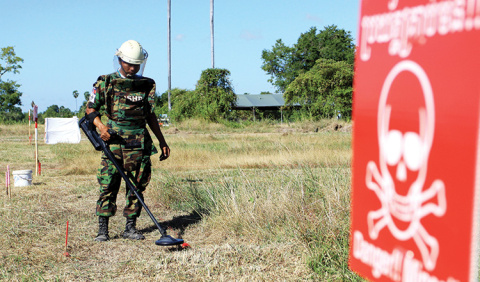
Speaking during an exclusive interview with Khmer Times yesterday, the First Vice-President of the Cambodian Mine Action and Victim Assistance Authority (CMAA) Ly Thuch praised the recently launched “4000 Riel Campaign” initiated by local private institutions, calling it a model example of what the private sector can do to help Cambodia rid itself of the deadly remnants of war.
An MoU was signed recently between Khmer Times publisher Mohan Bandam, Han Peng Kwang, Chief Executive Officer of Wing Bank, Oknha Tan Khee Meng, president of the Malaysian Business Chamber of Commerce, and a CMAA representative to kick start the campaign, which allows the public to contribute to the cause of mine clearance in Cambodia simply by donating a dollar or 4,000 riels.
The event was also attended by Thuch, Ly Panharith, Secretary General of CMAA, and Datuk Eldeen Husaini Mohd Hashim, Ambassador of Malaysia to Cambodia.
To kickstart the mine clearing project, $2,000 was pledged by MBCC and another party, which can help demine up to one hectare of contaminated land and spearhead the campaign, coined as the “4,000 Riel Campaign” since 4,000 riels can demine about five square metres of contaminated land.
Appearing on the latest episode of Cross-Talk yesterday, Thuch said the four parties who signed the MoU have displayed an exemplified effort to join hands with the government to achieve its vision in accordance with the National Strategic Plan for Mine Action 2018-2025 and the goal of mine-free status by 2025.
“By extending the help, they are saving the lives of Cambodian people and at the same time securing more arable land for people to farm on,” he said. “4,000 riels can allow us to clear up to five square metres of contaminated land. If everyone joins hands on this, we can achieve a magnificent result.”
Exactly one year ago, Prime Minister Hun Sen announced his commitment to remove all landmines from Cambodia’s soil through the “national movement” to truly make Cambodia mine-free by relying on public funding in addition to foreign aid.
Later, the Premier announced the creation of the “Providing Safe Ground, Creating Smiles” project, which so far has allocated $18 million for demining, and banking accounts through which the public can contribute.
“Asking the public to join hands with the government to remove landmines from Cambodia’s territory has produced a wonderful outcome,” Thuch added. “Every day, we receive donations via the public account. Some of them are as much as 1,000 riel (25 cents), but every cent is important as we are trying to achieve the 2025 goal.”
“Meanwhile, I really appreciate private companies and institutions that have come up with initiatives to bring us the much-needed resources on our journey.”
Khmer Times and MBCC are not strangers to the cause.
Last year, Khmer Times became one of the first private companies and the first ever media outlet to sponsor a demining operation that resulted in Veal Village in Kampong Speu being declared mine-free. In August, MBCC organised a Charity Gala Dinner which resulted in raising $77,700 for demining efforts.
“I am very impressed by the MBCC’s contribution to our cause,” Thuch said. “Although Cambodia is not their home country, they have put in so much effort in giving back to a country in which they have been doing business and making profit thanks to the hard-earned peace. I also would like to thank the Malaysian Ambassador who has been very active in driving businesses to participate in the cause – in addition to creating job opportunities and boosting the national economy.”
A big challenge is still ahead
Cambodia is one of the countries worst-affected by landmines, ERWs, and cluster munitions. An estimated 4 million to 6 million landmines and other munitions had been left over from three decades of war and internal conflicts.
According to CMAA, Cambodia had cleared some 2,579 square kilometres of landmines and explosive remnants of war (ERW) contaminated land in the last 30 years.
“For 30 years, the international community and the United Nations have worked side by side with Cambodia to clear roughly 2,579 square kilometres of landmine/ERW contaminated land from 1992 to 2022,” Thuch said. “This land has been returned to communities for productive purposes such as agriculture, resettlement, roads, schools, and other social infrastructure.”
The Senior Minister added that 2023 will be a historic year, as nearly 360 square kilometres of contaminated land will have been released, and a total of 18 provinces will achieve landmine-free status by the end of the year.
However, he added, Cambodia still has 563 square kilometres contaminated with landmines and 1,322 square kilometres contaminated with cluster munitions and other ERWs, threatening the lives of nearly one million people and obstructing economic development.
“These landmines stay buried in the most inaccessible areas, including mountainous regions along the border,” Thuch said. “Those are the most difficult operations, and in some of those places, we cannot use heavy machinery or even dogs and rats trained to sniff for explosives.”
“In fact, for now, I cannot guarantee that the 2025 goal will be 100% achieved. We have several factors to determine that, including human resources, financial resources, and equipment.”
CMAA needs $78 million for the operation in 2024 and 2025.
“Whether we can fulfill this crucial mission or not depends on everybody,” Thuch said.




